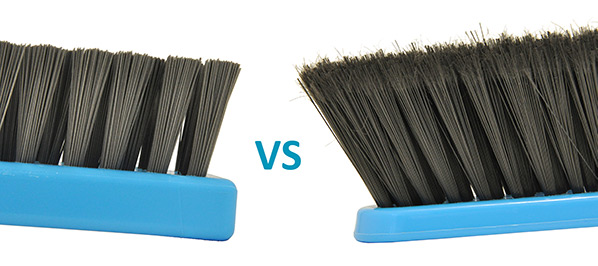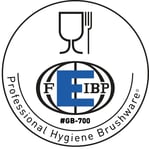
Flagged fibres are generally considered to have good sweeping abilities for fine particles, but it is worth considering how they are manufactured and what that means for their intended use in the food industry and other sectors.
The Process
Flagged fibres are manufactured by splintering about a 1cm end section of the filament. This splintering creates a fluffier, thicker fill on the ends of the brush filaments, which is considered much better for sweeping dry areas and smooth surfaces such as laminate.
The flagged fibres can however trap both dirt and bacteria and also splinter into the product or onto the surface being cleaned. In food production areas such as bakeries, where fine particle ingredients such as flour or sugar are used, fibre fragments can be lost and end up in the food. This can provide a real risk of end product contamination and the resulting cost and brand damage of a product recall.
The use of flagged fibres is common within the brush making industry, and they have their use, just not in food contact areas. Our recommendation for sweeping fine particles in dry food production areas is a brush with extra soft of crimped plastic filaments. Both options with a suitably thick and well-arranged will in the brush head are the most hygienic choices for any light sweeping or this kind.
 FEIBP
FEIBP
To further illustrate this, the FEIBP (European Brushware Federation) guidelines state that no flagged fibres are to be allowed or used in food contact areas:
2.1 Brush Components.
The brush components must be made of materials resistant to solvents, chemical cleaning agents and temperatures required for disinfection. The components must not contain chlorine. Any additives/compounds or colourants must be food grade of a recognised standard, and must not contain lead, mercury or cadmium. No hollow or flagged fibres are to be allowed or used.
Hillbrush is registered with the FEIBP, which was set up in 1995 to satisfy the market requirement for a definition of hygiene brushware. The Charter enables users to be confident that the brushes they are using comply with existing hygiene standards. All Hillbrush products intended for food contact use do not contain flagged fibres and are compliant with all FEIBP standards for food contact use.
To find out more about the FEIBP regulations and what is and isn't suitable for food contact use, click here to see our accreditations and scroll down to find the FEIBP section.


.jpg)